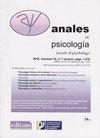在惊喜和不确定的背景下检测人脸
IF 1.3
4区 心理学
Q3 PSYCHOLOGY
引用次数: 0
摘要
威胁的表情被迅速而准确地检测出来,警告观察者潜在危险的存在。在检测过程中,惊讶的面部表情可以在不确定的条件下作为方向的线索发挥重要作用,这需要快速而精确的反应。为了分析这种偶然性,我们对70名被试进行了一项空间线索任务,其中惊奇的面部表情(与中性的面部表情)作为定向线索,恐惧、愤怒和快乐的面部表情作为目标刺激。结果显示,惊讶的表达在检测愤怒的表达时具有启动效应,减少了反应时间和错误率。数据表明,惊讶的表达,当作为一个独立的刺激处理时,可以启动那些构成直接威胁的刺激的检测,比如愤怒的表达,这是理解愤怒的表达比其他类型的表达更有效检测的环境的关键区别。通过precisión的快速检测,通过观察,通过潜在的peligro的存在,可以快速检测到潜在的peligro。Durante el process de detección, la expresión de sorpresa podría jugar和paper important como clave de orientación在条件不确定的情况下,需要一个响应rápida y precisa。conel objtivo de analiar estutose plateó unexperimental enenque参与者70个受试者的que realizon one area señalización特别,don ' s use of expression ones faciales de sorpresa (vs. neutras como) comaves de orientación, y expression ones faciales de miiedo, ira, alegría y neutras como estímulos objtivo。结果显示,最有效的促进者de la expresión de sorpresa solo和de la detección de la expresión de ira,减少了损失的时间,从而减少了错误的机会。洛拿督apuntan公式sorpresa表达式的值,cuando se procesa科莫联合国estimulo独立队,podria facilitar la deteccion de aquellos estimulos, supongan una amenaza directa,科莫la表达式的值de ira siendo esta立场劈开对位entender en,身体状况se detecta mas eficazmente la表达式的值de ira respecto又蒂波德表达式的值。本文章由计算机程序翻译,如有差异,请以英文原文为准。
Detectando caras en un contexto de sorpresa e incertidumbre
Threatening expressions are detected quickly and accurately, warning the observer of the presence of a potential danger. During the detection process, a facial expression of surprise could play an important role as a cue for orientation in conditions of uncertainty that call for a swift and precise response. With a view to analysing this contingency, an experiment was conducted in which 70 subjects undertook a spatial cueing task that involved facial expressions of surprise (vs. neutral ones) as orientation cues, and facial expressions of fear, anger and happiness as target stimuli. The results revealed a priming effect of the expression of surprise solely in the detection of the expression of anger, reducing response times and the percentage of errors. The data indicate that the expression of surprise, when processed as an independent stimulus, could prime the detection of those stimuli that constitute a direct threat, such as the expression of anger, with this being a crucial distinction for understanding the circumstances in which the expression of anger is detected more effectively than other kinds of expressions.
Las expresiones de amenaza son detectadas con rapidez y precisión, advirtiendo a quienes las observan de la presencia de un potencial peligro. Durante el proceso de detección, la expresión de sorpresa podría jugar un papel importante como clave de orientación en condiciones de incertidumbre donde se requiere una respuesta rápida y precisa. Con el objetivo de analizar este supuesto se plateó un experimento en el que participaron 70 sujetos que realizaron una tarea de señalización espacial, donde se utilizaron expresiones faciales de sorpresa (vs. neutra) como claves de orientación, y expresiones faciales de miedo, ira, alegría y neutras como estímulos objetivo. Los resultados mostraron un efecto facilitador de la expresión de sorpresa solo en la detección de la expresión de ira, reduciendo los tiempos de respuesta y el porcentaje de errores. Los datos apuntan a que la expresión de sorpresa, cuando se procesa como un estímulo independiente, podría facilitar la detección de aquellos estímulos que supongan una amenaza directa, como la expresión de ira, siendo esta distinción clave para entender en qué condiciones se detecta más eficazmente la expresión de ira respecto a otro tipo de expresiones.
求助全文
通过发布文献求助,成功后即可免费获取论文全文。
去求助
来源期刊

Anales De Psicologia
医学-心理学
CiteScore
3.30
自引率
5.90%
发文量
57
审稿时长
4-8 weeks
期刊介绍:
Anales de Psicologia / Annals of Psychology is a multidisciplinary journal of the various thematic areas of scientific psychology. It publishes original research articles and theoretical review in any of its basic, applied and methodological areas included within psychology.
Publishing, financing, marketing and distribution corresponds Editum: Editions of the University of Murcia (Spain). The organizational guidelines and editorial policies come from the Editorial Team (elected for four years by the Areas and / or Departments of Psychology at the University of Murcia) and the Editorial Board, composed of scholars and experts from different universities and institutions national and international. It is published in print (ISSN: 0212-9728) since 1984 and in Internet publishing (web) (ISSN: 1695-2294) since 2000. Available online full text in pdf from the vol. 1 1984.
Anales de Psicologia / Annals of Psychology maintains a system of exchange with other journals and publications of psychology in the world. Through an free exchange agreement with their respective publishers or entities responsible for editing, these journals and publications are received at the University of Murcia (Biblioteca "Luis Vives", near the Faculty of Psychology) and in return, our journal is sent to libraries and educational and research institutions such centers responsible for editing.
 求助内容:
求助内容: 应助结果提醒方式:
应助结果提醒方式:


